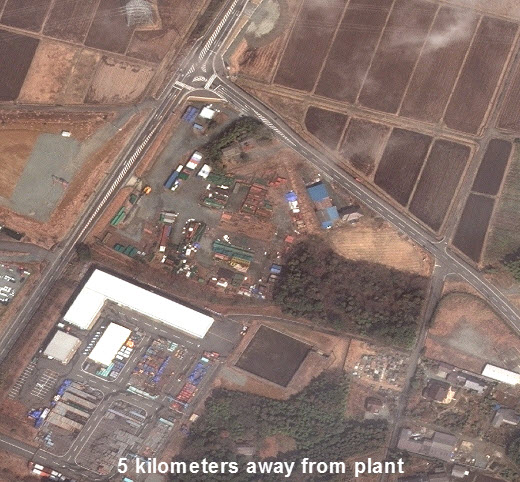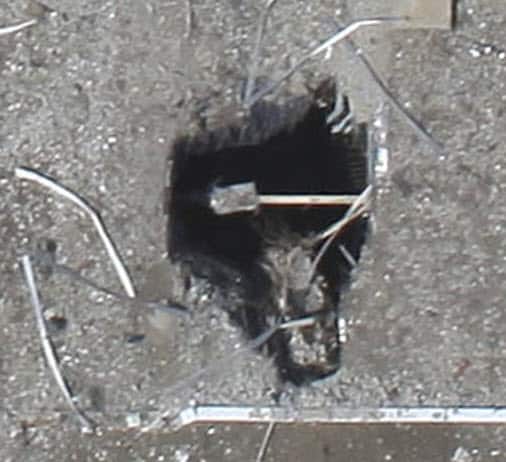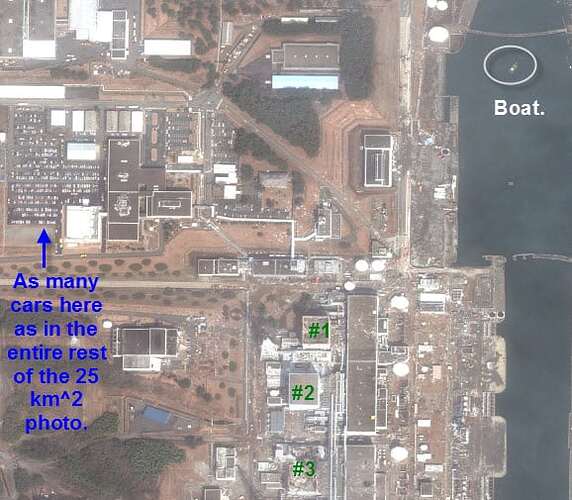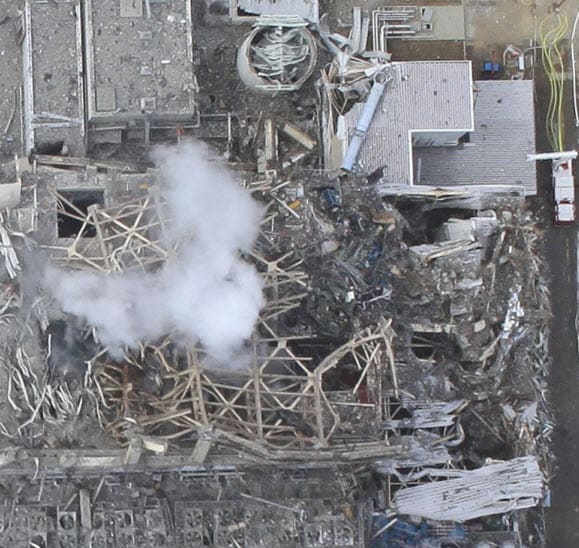Noting that the press has largely turned its resources off of the Fukushima complex, and needing up-to-date information on the status of the damage control efforts there, we secured the most up-to-date satellite photo from DigitalGlobe (dated March 31st), which we analyze below. This is the first photo of the damaged reactor site at Japan's Fukushima Dai-ichi nuclear facility made available to the public in over a week. That means you, our readers, are the first public eyes anywhere to see this photo.
Drawing upon the expertise of our resident nuclear engineer and Ann Stringer, imaging expert, we conclude that the situation at Fukushima is not stabilized: Things are not yet at a place of steady progress in the containment and clean-up efforts. It's still a dance, forwards and backwards, with the workers making gains here and there but the situation forcing them to react defensively all too often.
In this report, we will tell you what we know for sure, what we are nearly certain of, and what we remain forced to speculate about.
Here is a portion of a much larger image (covering 25 square kilometers in total) showing the reactor complex as of March 31, at roughly mid-day:
Photo Credit, 2011, DigitalGlobe
What We Can See
Here's what we can directly observe in the larger satellite image:
- Steam is still rising from Reactors #2, #3 (circled in green), and #4.
- Of the four reactor buildings, three are nearly or totally destroyed, while the outside (at least) of the fourth is in relatively better shape.
- We can count 7 fire trucks 'on site' with another 7 just to the north, all with water lines strung out across the ground.
- There is only one ship/vessel to be seen, located inside of the breakwater and nearly as far to the north as it can go inside that boundary.
- A significant number of the vehicles that can be seen at the core of the site have not moved since the first released photos on March 12.
- There is a parking lot slightly to the north and west with approximately 250 passenger vehicles in it and a side lot with 30 large green tanks neatly arranged in rows.
- The rest of the area contains one-, two-, and four-lane roads (no traffic at all), worked farmland, residential and commercial areas, mostly empty parking lots, and two baseball diamonds.
Here's what we don't see...
- Nowhere in the 25 km area in the main photo can we find anything that looks like a staging area with a large collection of assets such as tanker trucks, pumpers, cement trucks, piles of pre-staged materials, ambulances, and fire trucks.
- The cement pumper truck seen a week ago has been apparently replaced by the boom at Reactor #4.
- There's no obvious barge delivering fresh water for the reactor cooling efforts as recently reported. (Perhaps it has come and gone?)
- There are no obvious changes to the roofs of any of the reactors.
- We don't see any people outside the plants working.

Things we can logically conclude...
The steam that is venting is a mixed blessing. It implies that cooling water is getting to some hot material, which is a good thing, but it also means that something is hot enough to vaporize water, leading to the continued release of radioactive contamination into the surrounding environment and further bombarding the reactor complex with radiation, which complicates the work efforts. [Note: prior sentence edited for clarity on April 2, 2011].
This means that the lack of steam coming from Reactor #1 is either a very good sign, or a very bad sign. Good because it could mean that the containment vessels are intact and cooling water is circulating. Bad because it could imply that no water is getting to it, and it is a very hot mass right now. According to TEPCO, Reactor #1 has had seawater, and now freshwater, circulating through the reactor vessel - and since both containment vessels are intact, we'll conclude the lack of steam is a good sign.
The situation at Fukushima is going to drag on for years. First there's the matter of stabilizing the situation, and this has not yet been fully achieved. Recent surprises in terms of the amounts and locations of radioactivity are one sign that the situation is not fully stabilized. Still, nothing has blown up in quite a while, the steam venting appears consistent, and the major surprises seem to be over for now. While the TEPCO workers are still reacting to things as they arise, these are smaller issues than last week, which is another hopeful sign.
The detected presence of neutron beams, I-134, and radioactive chlorine are all strongly supportive of the idea that criticality has resumed. Our best guess is that these are localized pockets, probably of short duration, and do not involve the entire core mass of any particular reactor conflagrating in some gigantic, greenish blob of uncontrolled fission. The geometries of the fuel in relation to neutron moderators requires precise conditions to support sustained fission and so it is rather unlikely to be occurring in anything other than localized pockets. If the entire reactor in its fully operational state was capable of supporting what we might scale to 100% fission, the amount of fission happening after a partial (or complete) meltdown will be a far lesser percentage. Still, any amount of fission is unwelcome at this point, because it is adding to the heat and generating fresh radioactive elements that can escape.
The constantly rising levels of radioactivity found in the seawater are a further unwelcome development, but without a proper isotope analysis, we cannot conclude anything about the potential resumption of fission from their gross amounts alone. It's always possible that the leftover fission products are now being washed in larger amounts into the sea for some reason.
Additional Drone Photos
These are the most detailed photos yet to emerge into the public space (released yesterday, March 31, as far as I know), and they are purported to come from a drone flyover on March 20 and 24. They are really quite good, and worth viewing in their entirety here.
Beginning with Reactor #3, one thing we can say is that this thing is a right proper mess:
(Source for all that follow)
There's a significant hole to the left of center that goes deep into the sub-structure (with a strange greenish cast that we've not been able to resolve after much conjecture) and it's clear that this building alone will take a long time to resolve.
Interestingly, we get our clearest image yet of the hole in turbine building #3 that was created by something ejected into the air during the Reactor #3 explosion.

Looking like one of those cartoon cutouts that happens when the coyote hits the ground, we get the impression that whatever it was happened to be quite heavy and possibly shaped like an Apollo capsule. It has been my suspicion, contradicting the official story, that the concrete containment vessel was what actually blew up in Reactor #3. I have been looking for evidence of in the form of large, heavy chunks of concrete (especially the refueling plug) lying about. I don't know what made this hole in the roof of the turbine building, but it was heavy.
Reactor #4 provides us with proof that serious damage can result from the effects of an overheated spent fuel storage pool:
Here the watering boom can be clearly seen. A camera was recently attached to the boom, and it took some interior shots that were suggestive of the idea that the spent fuel pool is damaged and largely drained of water. Spraying water into this pool, then, is probably a balancing act, with the desire to spray enough water on the rods to keep them cool being offset by the risk of having radioactive water drain away for parts unknown.
Almost certainly this same balancing act defines the efforts for Reactors #2 and #3 as well.
Conclusions
The efforts at Fukushima are probably weeks away from even basic stabilization, and we are years away from any sort of a final resolution. This crisis is going to be with all of us for a very long time. Radioactive material will continue to escape from the complex into the environment for weeks at best, and months or years at worst.
The chief concern here is that things might still take a turn for the worse, whereby radiation spikes to levels that prevent humans from getting close enough to perform meaningful operations and work on the site. If the radiation spikes high enough, it will force an evacuation from the vicinity, complicating every part of what has to happen next, from monitoring to remediation.
The general lack of staged materials anywhere in the vicinity indicates that authorities have not yet decided on a plan of action, feeding our assessment that they are still in 'react mode' and that we are weeks away from nominal stabilization.
On Thursday we learned from the Wall Street Journal that TEPCO only had one stretcher, a satellite phone, 50 protective suits, and enough dosimeters to give only a single one to each worker group. Given this woeful level of preparation, it is not surprising to see that regular fire trucks, cement trucks, and a lack of staged materials comprise much of the current damage-control mix.
We don't yet know enough to conclude how much fission has spontaneously re-occurred, but we have strong suspicions that the number is higher than zero. Here we make our call for the release of more complete and timely radiation readouts and sampling results by TEPCO and Japan so that we can assess what the true risks are. The situation remains fluid, and quite a lot depends now on chance and which way the wind blows.
And as I detailed in the Alert report I issued soon after the tragic events of the Japan earthquake and tsunami on March 10, the impact of Japan's tribulations on the global economy will be large and vast. World markets are simply unprepared for the third-largest economy to suddenly and violently downshift. The persisting crisis at Fukushima simply worsens the picture.
As always, we'll continue montioring developments closely and reporting our findings and conclusions on this site.
best,
Chris
This is a companion discussion topic for the original entry at https://peakprosperity.com/exclusive-photos-latest-satellite-imagery-from-fukushima-tells-sobering-tale-2/




